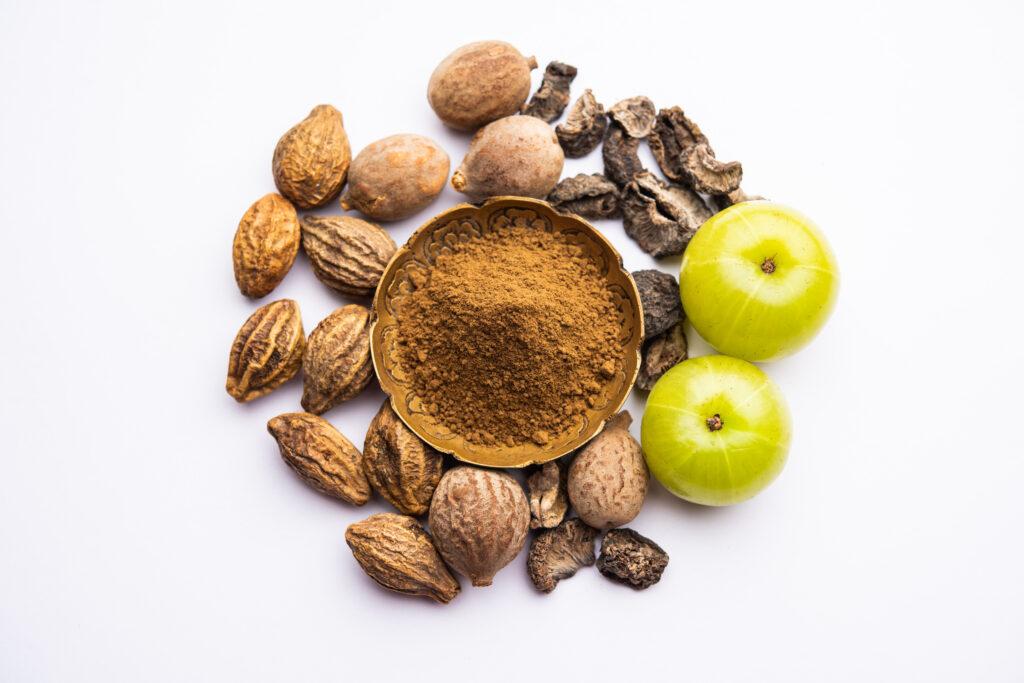Triphala and Ayurveda

Three medicinal herbs make up Triphala (in Sanskrit, “tri” means “three” and “phala” means “fruits”). Triphala is an antioxidant-rich herbal preparation described as a Rasayana (rejuvenator) medicine by Ayurveda experts. Moreover, the combination of the three fruits is responsible for Triphala’s numerous health benefits.
Triphala is made from dried fruits of three different plants: Terminalia chebula (black myrobalan), Terminalia bellerica (bastard myrobalan), and Phyllantus emblica (emblic myrobalan or Indian gooseberry). The spring-harvested fruits of Terminalia chebula are high in tannins such as gallic acid, ellagic acid, chebulic acid, chebulinic acid, chebulagic acid, neochebulinic acid, corilagin, terchebin, punicalagin, and terfavin, flavonoids (rutins, luteolin and quercetin), starches, amino acids (glutamic acid, aspartic acid, lysine, arginine, and proline), ß-sitosterol, succinic acid, fructose, and fatty acids.
Constituents of Triphala
The fruits of Terminalia bellerica consist of proteins and oils that include omega-3 and omega-6 fatty acids (linoleic acid). Because of its high fatty acid content, this plant can impact cholesterol levels, increasing high-density lipoprotein levels (good cholesterol) while decreasing low-density lipoprotein levels (bad cholesterol), making it effective in treating coronary artery disease. Phyllanthus emblica (amla) fruits are high in ascorbic acid i.e. vitamin C.
The high density of tannins may add to the overall bitterness of amla. These fruits also include punicafolin and phyllanemblinin A, phyllemblin, and other polyphenols such as gallic acid, ellagic acid, flavonoids, and kaempferol.
Possible therapeutic Uses of Triphala
Triphala is a tridoshic Rasayana in Ayurveda, capable of balancing and rejuvenating the three doshas that regulate human life: Vata, pitta, and Kapha. It is widely used in several disease conditions owing to its following effects:
- laxative
- anti-inflammatory
- antiviral
- Blood purifying
- analgesic
- anti-arthritic
- hypoglycemic
- anti-ageing
- antibacterial
Thus, Triphala can treat fatigue and oxidative stress and can help to treat infectious diseases like tuberculosis, pneumonia, AIDS symptoms, and periodontal disease, among others. It is also excellent for headaches, dyspepsia, ascites, and leukorrhea.
Possible Benefits of Triphala for Ayurveda
Infections and Triphala
- Triphala and its components have shown potent antimicrobial effects against a variety of microorganisms.
- Triphala churna has proven action against the human immunodeficiency virus (HIV), it can help in the therapy against the virus.
- Triphala churna and Triphala Mashi have shown antibacterial effects against a variety of bacteria like E. coli and S. aureus.
Triphala for Dental Care
- Triphala reduced levels of chemicals that play a big role in tissue destruction during periodontitis.
- In clinical tests, Triphala mouthwash was as effective as chlorhexidine in lowering plaque scores and inhibiting Lactobacillus bacteria microbial levels.
Triphala and Stress for Ayurveda
- Triphala supplementation can alleviate stress.
- Triphala treatment can prevent cold stress-induced behavioral and biochemical abnormalities by increasing lipid peroxidation and corticosterone levels.
- In rats, Triphala protects against noise-induced alterations in antioxidant and cell-mediated immune response.
Joint and Triphala
- Triphala prevented monosodium urate crystal-induced arthritis in mice (gouty arthritis) by reducing various parameters like paw volume, lysosomal enzymes, ß-glucuronidase lactate dehydrogenase lipid peroxidation, and the proinflammatory cytokine tumour necrosis factor-alpha, according to research.
- It might have potential use in the treatment of gout in humans, however, it is important to perform more studies to confirm.
Triphala for Digestive Tract for Ayurveda
- The extracts of Triphala churna powder and Triphala Mashi prevented castor oil-induced diarrhea
- The extracts had a strong antidiarrheal effect, as demonstrated by increased first defecation time, cumulative fecal weight, intestinal transit time, improved stool volume, stool frequency, stool consistency, decreased mucus level in stool, and flatulence.
Liver and Triphala
- In mice tests, Triphala was beneficial against acetaminophen-induced liver damage, but with less efficacy than silymarin.
- Triphala lowered the levels of proinflammatory cytokines and lipid peroxides while also restoring the levels of many antioxidant enzymes and reducing liver damage as seen by lower liver enzyme values.
Diabetes and Triphala
- Animal studies have demonstrated that giving the same amount of triphala and its separate ingredients to normal and alloxan-induced diabetic rats lowered serum glucose levels.
- Thus, with more research, Triphala might be useful in treating diabetes in humans.
Also check out our articles on type 1 diabetes and type 2 diabetes.
Obesity and Triphala
- After the treatment of mice with Triphala in an anti-obesity study, their body weight was lower when compared to control animals.
- Gallic acid is a phenolic molecule in triphala that was chosen as the bioactive marker because of its anti-obesity activity.
Triphala and Heart for Ayurveda
- Triphala has been found to have a lipid-lowering impact on rats, with significant reductions in total cholesterol, low-density lipoprotein, very low-density lipoprotein, and free fatty acid, indicating hypocholesterolemic condition.
- These properties make it cardio-protective.
Triphala for Skin
- The topical application of triphala extract aided wound healing in rats infected with a variety of bacteria, according to a study.
- Experiments revealed that the triphala ointment reduced bacterial count and promoted wound closure by increasing collagen, hexosamine, and uronic acid levels.
Radioprotective activity
- Preclinical trials proved that Triphala has radioprotective properties when taken orally.
- The most effective action of Triphala was seen when given before irradiation, lowering DNA damage in both blood white blood cells and spleen cells, and the normalizing activity of certain enzymes like xanthine oxidase and super oxidase dismutase found in the intestine.
- This indicates that the observed effects were mediated through the inhibition of oxidative damage in the cells and organs.
Immunity and Triphala for Ayurveda
- Triphala has shown potent immunomodulatory properties in a variety of animal models.
- Flavonoids, tannins, alkaloids, glycosides, saponins, and phenolic substances are thought to have immunomodulatory properties.
- Triphala treatment increased antioxidant activity and lowered corticosterone levels in animals exposed to noise stress, according to research.
Antioxidant activity
- According to research, taking triphala boosts the activity of antioxidant enzymes which may have resulted in a considerable reduction in stomach cancers in mice.
- When rats were given Triphala and were subjected to noise stress, similar results were reported.
- Such findings point to triphala’s ability to act as an antioxidant and to protect against a variety of stressors and illnesses.
Eyes and Triphala
- Triphala was found to be beneficial in preventing and reducing selenite-induced cataract formation, according to a study.
- In animal trials, triphala restored antioxidant enzyme levels, resulting in a reduction in nuclear cataracts. As per Ayurveda, triphala can also help prevent blindness and near-sightedness.
Cancer and Triphala
- In cancer studies, triphala has shown killing activity on cancer cells.
- Its main component gallic acid may be responsible for stopping cancer cell growth.
- An increased concentration of triphala was found to reduce the viability of breast cancer cells while having no effect on normal breast cells.
- In breast cancer cells, triphala caused an increase in intracellular reactive oxygen species.
Aging and Triphala
- On human skin cells, triphala extract can have a strong anti-aging effect.
- It stimulates collagen-1 and elastin-synthesizing genes and antioxidant genes responsible for cellular antioxidants in human skin cells.
- Due to the presence of protective phytochemicals, it suppresses melanin synthesis and hyperpigmentation.
You can find more information in this paper
Triphala churna (Powder) for Ayurveda
Haritaki, Bibhitaki, and Amalaki are powdered to make Triphala churna (powder). Furthermore, as per research, it is advisable for Ayurveda to take Triphala with ghee, honey, or milk.
Eyewash: Soak one spoon of Triphala powder in a bowl of water at night. Then, filter it with a cloth in the morning and wash your eyes with that water. This experiment is very beneficial for the eyes. In Addition, this makes the eyes clean and the vision subtle. It helps to treat eye irritation, redness, etc.
Gargle: Firstly, keep Triphala soaked in water overnight. Keep this water in your mouth after brushing your teeth in the morning. Take it out after a while. Due to this, teeth and gums remain strong till old age. It destroys distaste, bad breath, and mouth ulcers.
Consuming Triphala powder with a mixture of cow’s ghee and honey (more ghee and less honey) can also be a boon for the eyes.
In addition, Triphala is beneficial in all urinary disorders and diabetes. Also, taking Triphala with lukewarm water at night helps with constipation.
Moreover, regular use of it along with a restrained diet can prevent the occurrence of eye diseases like cataracts, glaucoma, short-sightedness, etc.
Last, the recommended Triphala dosage: Take 2 to 4 grams of powder after lunch or at night with lukewarm water.
Triphala kwatha (Decoction)
To make it, combine the powder with water and boil it. Then, filter the decoction through a clean cloth. Thus, the filtrate can be used to treat skin conditions like erysipelas, eruptions, scrotal enlargement, colic pain, worm infestation, and urinary diseases. It is applied directly to open wounds and eyes, as well as gargled during pharyngitis.
Drinking lukewarm decoction of Triphala mixed with honey can help with obesity. Also, Triphala decoction has an antiseptic effect, using it in wounds can help them to heal quickly.
Triphala taila (Oil) and Ayurveda
To make this medicine from Ayurveda, boil Triphala powder with oil. Then, you can use it as a gargle, snuff, an enema, and orally to treat obesity and itching.
Triphala masi (Ash)
To make it, heat triphala powder for a long time at a low temperature in a controlled setting. In addition, Mashi/Masi is an intermediate product containing organic and inorganic ingredients. The mashi is black and has a high carbon and oxide content. You can use Triphala mashi, when mixed with honey, to treat soft chancres and wounds.
Triphala gritha (in ghee or clarified butter)
It is made by cooking the paste of triphala, trikatu (a herbal compound of Indian Long Pepper (Piper longum), Black Pepper (Piper nigrum), and Ginger (Zingiber officinale) in ghee and milk, as well as grapes (Vitis vinifera), Yestamadhu (Glycyrrhiza glabra), Kutki (Picrorhiza korroa), and cardamom (Elettaria cardamom). Moreover, it is frequently used to treat eye conditions like conjunctivitis, blindness, and cataracts. Triphala gritha is also used to treat jaundice, leucorrhoea, tumours, greying, and hair loss.
Ayurveda Precautions to Take with Triphala
Terminalia chebula (one part of Triphala): Don’t use it if you have an acute cough, diarrhea, or early-stage dysentery.
Caution: Weak, emaciated, in fever people and pregnant women should not consume Triphala. If you want to consume milk, then keep a gap of 2 hours between the consumption of milk and Triphala.
Last, for more information on precautions to take Triphala, check out this paper.
Browse the compendium:
0. Ayurvedic Expert Consultation
0.1. Ayurvedic Treatments
1. About Ayurveda
1.1. Doshas and Energy Elements
1.2. Which is your Dosha?
2. Healthy Life
3. Beauty and Ayurveda
4. Balance your Weight
5. Ayurvedic Medicines
5.1. Food as Ayurvedic Medicines
5.2. Herbal Ayurvedic Medicines
5.2.1. Triphala and Ayurveda
5.3. Spices as Ayurvedic Medicines
6. Balance your Stress
7. Ayurveda Cooking
7.1. Ayurveda Recipes
8. Diabetes and Ayurveda
9. Yoga, Meditation and Pranayama
10. Ayurveda Approach for Diseases
